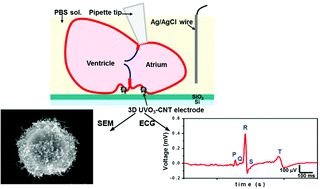Direct-growth carbon nanotubes on 3D structural microelectrodes for electrophysiological recording†
Abstract
A novel 3D carbon nanotube (CNT) microelectrode was developed through direct growth of CNTs on a gold pin-shaped 3D microelectrode at a low temperature (400 °C) for applications in neural and cardiac recording. With an electroplated Ni catalyst layer covering the entire surface of the pin-shaped structure, CNTs were synthesized on a 3D microelectrode by catalytic thermal chemical vapor deposition (CVD). According to the analyses by electrochemical impedance spectroscopy, the impedance of 3D microelectrodes after CNT growth and UV/O3 treatment decreased from 9.3 Ω mm−2 to 1.2 Ω mm−2 and the capacitance increased largely from 2.2 mF cm−2 to 73.3 mF cm−2. The existence of UVO3-treated CNT led to a large improvement of interfacial capacitance, contributing to the decrease of impedance. The electrophysiological detection capability of this 3D CNT microelectrode was demonstrated by the distinguished P waves, QRS complex and T waves in the electrocardiogram of the zebrafish heart and the action potential recorded from individual rat hippocampal neurons. The compatibility of integration with ICs, high resolution in space, electrophysiological signals, and non-invasive long-term recording suggest that the 3D CNT microelectrode exhibits promising potential for applications in electrophysiological research and clinical trials.

- This article is part of the themed collection: Clinical spectroscopy

 Please wait while we load your content...
Please wait while we load your content...